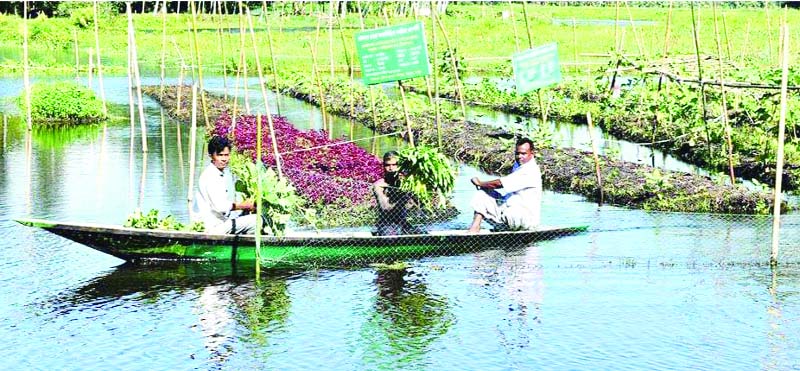
Mintu Abdur Rahman ,Rangpur :
A good number of landless peasants under Pirgachha upazila in Rangpur district are getting financially benefited through farming vegetables on floating gardens prepared in abandoned water bodies at Annadanagar area of the upazila.
These extreme poor people have shown how to cop with the adversecircumstances by adopting such innovative method of food production fortheir survival. Despite having no piece of cultivable lands of their own they have achieved remarkable success in farming crops on floating gardens in discarded waterbodies. Thus they are also encouraging others to follow their example.
The farmers are cultivating different varieties of vegetables including bottlegourd, bean, cucumber, eggplants and various leafy vegetables without usingany pesticides and chemical fertilisers, sources said.”We do not use any pesticides or chemical fertilisers to grow vegetables onfloating gardens. Such vegetables are fresh, tasty and healthy, said farmer Bablu Mia. Locals come to them to buy toxin free vegetables produced on floating gardens. Prices of such vegetables are also higher than that of the usuallycultivated ones, he also said.
According to sources, a floating garden is constructed using water hyacinth,which is collected to erect a floating raft and tightened with bamboo. This should be covered with soil and cow dung in which vegetables can beplanted, sources also said. The rafts can be eight metre long and one metre wide and are made from hyacinth. Soil is put on the surface of the raft andthen the seeds or saplings are planted in the soil. Both summer and winter vegetables can be grown on this floating garden, sources added .Merely physicall abour is required to build a floating vegetable garden”,said farmer Asadul. “I had to spend a small amount for organic fertiliser andseeds,” he further said. “I got necessary advices and assistances from local agriculture office for constructing floating vegetable gardens in forsaken water bodies”, farmer Alam Mia said. A total of 80 floating beds have been set up so far for farming vegetables in the area, he added. “When our homes and fields get flooded by torrential rains these vegetables of floating garden manage to survive. We make curries out of these vegetables and feed our children”, growers said. Upazila Agriculture officer Shamimur Rahman said using local resource sparticularly water hyacinths, the method is an environmentally sustainable touse wetland as well as water logged areas for vegetable farming. Due to lowproduction cost gradually more farmers are getting interested in this method.They are optimistic about expanding such method of vegetable farming on floating garden in more areas under the upazila within next year, he added
A good number of landless peasants under Pirgachha upazila in Rangpur district are getting financially benefited through farming vegetables on floating gardens prepared in abandoned water bodies at Annadanagar area of the upazila.
These extreme poor people have shown how to cop with the adversecircumstances by adopting such innovative method of food production fortheir survival. Despite having no piece of cultivable lands of their own they have achieved remarkable success in farming crops on floating gardens in discarded waterbodies. Thus they are also encouraging others to follow their example.
The farmers are cultivating different varieties of vegetables including bottlegourd, bean, cucumber, eggplants and various leafy vegetables without usingany pesticides and chemical fertilisers, sources said.”We do not use any pesticides or chemical fertilisers to grow vegetables onfloating gardens. Such vegetables are fresh, tasty and healthy, said farmer Bablu Mia. Locals come to them to buy toxin free vegetables produced on floating gardens. Prices of such vegetables are also higher than that of the usuallycultivated ones, he also said.
According to sources, a floating garden is constructed using water hyacinth,which is collected to erect a floating raft and tightened with bamboo. This should be covered with soil and cow dung in which vegetables can beplanted, sources also said. The rafts can be eight metre long and one metre wide and are made from hyacinth. Soil is put on the surface of the raft andthen the seeds or saplings are planted in the soil. Both summer and winter vegetables can be grown on this floating garden, sources added .Merely physicall abour is required to build a floating vegetable garden”,said farmer Asadul. “I had to spend a small amount for organic fertiliser andseeds,” he further said. “I got necessary advices and assistances from local agriculture office for constructing floating vegetable gardens in forsaken water bodies”, farmer Alam Mia said. A total of 80 floating beds have been set up so far for farming vegetables in the area, he added. “When our homes and fields get flooded by torrential rains these vegetables of floating garden manage to survive. We make curries out of these vegetables and feed our children”, growers said. Upazila Agriculture officer Shamimur Rahman said using local resource sparticularly water hyacinths, the method is an environmentally sustainable touse wetland as well as water logged areas for vegetable farming. Due to lowproduction cost gradually more farmers are getting interested in this method.They are optimistic about expanding such method of vegetable farming on floating garden in more areas under the upazila within next year, he added

